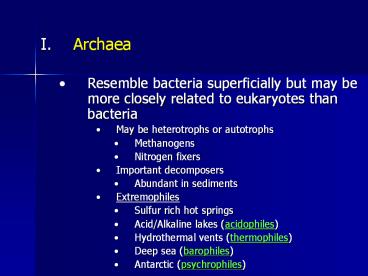Archaea - PowerPoint PPT Presentation
Title:
Archaea
Description:
Archaea. Resemble bacteria superficially but may be more closely related to ... Some forms live symbiotically with corals, anemones, jellyfish, giant clams, sponges ... – PowerPoint PPT presentation
Number of Views:1148
Avg rating:3.0/5.0
Title: Archaea
1
- Archaea
- Resemble bacteria superficially but may be more
closely related to eukaryotes than bacteria - May be heterotrophs or autotrophs
- Methanogens
- Nitrogen fixers
- Important decomposers
- Abundant in sediments
- Extremophiles
- Sulfur rich hot springs
- Acid/Alkaline lakes (acidophiles)
- Hydrothermal vents (thermophiles)
- Deep sea (barophiles)
- Antarctic (psychrophiles)
2
- Unicellular Algae
- Eukaryotes
- Photosynthesis in chloroplasts
- Lack flowers, stems, leaves, roots
- Diatoms (Bacillariophyta)
- Unicellular
- May form chains
- Cell enclosed by silica (SiO2) frustules (test)
- Test usually perforated and ornamented with
spines or ribs (Why?) - Perforations allow gases, nutrients, waste
products to pass through test to cell - Important open-water primary producers,
especially in temperate and polar regions
Fig. 4.8b
Fig. 15.3a
3
Fig. 5.5
4
- Unicellular Algae
- Diatoms (Bacillariophyta)
- Reproduction
- Asexual - Cell division
- Sexual - Egg Sperm --gt Auxospore
Fig. 5.6
5
- Unicellular Algae
- Diatoms (Bacillariophyta)
- Reproduction
- Explosive population growth --gt Bloom
- May deplete nutrients locally
- Sediments beneath areas where diatoms are
abundant may contain many tests - Diatomaceous oozes
- Diatomaceous earth
6
- Unicellular Algae
- Dinoflagellates (Dinoflagellata/Pyrrophyta)
- Possess two flagella
- Motile
- Covered with theca made of cellulose plates
- Theca may have spines
Fig. 5.7a
7
- Unicellular Algae
- Dinoflagellates (Dinoflagellata/Pyrrophyta)
- Possess two flagella
- Motile
- Covered with theca made of cellulose plates
- Theca may have spines
- Important open-water primary producers,
especially in tropical regions - Trophically diverse
- Autotrophic
- Heterotrophic
- Mixotrophic
- May bloom like diatoms
- Red tides
- Brown tides
8
http//www.whoi.edu/redtide/
9
- Unicellular Algae
- Dinoflagellates (Dinoflagellata/Pyrrophyta)
- Some forms live symbiotically with corals,
anemones, jellyfish, giant clams, sponges - Zooxanthellae
- Lose flagella
- Especially important in reef building corals
- Some forms can be extremely toxic
- Pfiesteria
- - Blooms triggered by coastal pollution
- - Toxin can cause memory loss in humans
10
- Unicellular Algae
- Other Algae
- Silicoflagellates (Chrysophyta)
- Silica test, usually with spines
- Single flagellum
- Coccolithophorids (Haptophyta)
- Covered by calcium carbonate coccoliths
- Coccoliths may be important components of
sediments - Cryptomonads (Cryptophyta)
- Lack skeleton
- Two flagella
Fig. 5.8
Fig. 5.9
11
- Protozoa
- Foraminiferans
- Test (shell) made of calcium carbonate (CaCO3) or
agglutinated sediment particles - Fossil tests used to age geological deposits
- May have multiple chambers
- Tests increase in size as organism grows
- Feed by extending pseudopodia through pores in
test - Trap bacteria and other small organisms/detritus
- Pelagic forms (calcareous)
- Often have spines
- Tests may form foraminiferan oozes, esp. in
shallow water beneath tropics (white cliffs of
Dover England) - Benthic forms (calcareous or agglutinated)
- Calcareous tests can be important sources of sand
for beaches
12
(No Transcript)
13
http//earthguide.ucsd.edu/earthguide/imagelibrary
/orbulinauniversa.html
http//www.ucl.ac.uk/GeolSci/micropal/foram.html
14
- Protozoa
- Radiolarians
- Test made of silica (SiO2)
- Tests may form radiolarian oozes, esp. in deep
water in temperate and polar regions - Feed by extending pseudopodia through pores in
test - Trap diatoms and other small organisms/detritus
(Why diatoms?) - Ciliates (Ciliophora)
- Use cilia
- Locomotion
- Feeding
- Free living
- Pelagic (Tintinnids)
- - Lorica
- Benthic
- Parasitic
15
http//rmbr.nus.edu.sg/research/terrestrial/fungi.
htm
- Fungi
- Unicellular or multicellular
- Mostly microscopic
- Heterotrophic
- Important decomposers
- Especially in mangrove forests
- Some disease causing forms
- Host to algae in lichens
16
- Multicellular Algae - Seaweeds
- Macroalgae
- Complex but lack specialized structures of true
plants - General Structure
- Body thallus
- Flattened portion blade
- Not true leaves
- No veins
- Upper and lower surfaces identical
- No tissues for transport of water, nutrients
minerals - Increase surface area (Why?)
- Main sites of photosynthesis
- Float pneumatocyst
- Anchor holdfast
- Do not penetrate sediment or absorb water
nutrients
17
Fig. 6.1































